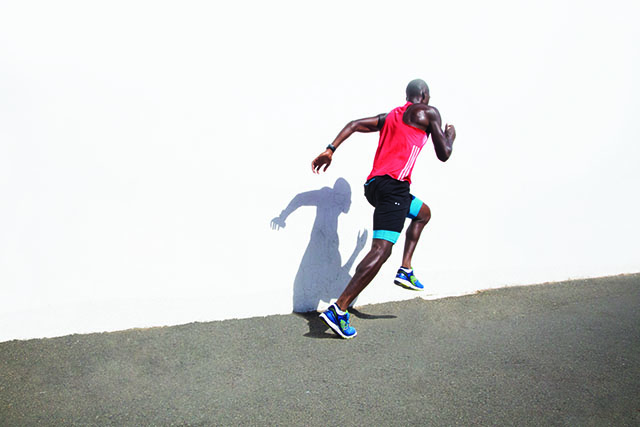Smash Your Best 5, 10, 21-K!
If you’re racing in a few months, it’s time to start preparing. Whether you’re a new runner, a speed demon, or just hoping to have the most fun ever, these expert tips will help you reach your goals.
GET READY FOR A 21-K

Who Are You?
A Hilly Half Fun-Runner
Your Goal:
Train Enough to Enjoy It
Hit the hills…
The only way to have fun at a race with a lot of ups and downs is to climb and descend regularly in training. “Instead of doing a speed-focused training cycle, it makes a whole lot more sense to focus on hills,” says coach Janet Hamilton (runningstrong.com). If you almost never run hills now, seek them out once a week: find a hill (or bridge or car park) that will allow you to climb for about 60 seconds, and run it a few times during a midweek run that’s longer than your shortest recovery runs. Once you’re comfortable with that, you can progress to a route with longer and/or steeper climbs, Hamilton says. Then, you can start adding some hills to your long runs – warm up with a few flat kilometres, run a few kays on rolling hills, and cool down with three more flat kilometres.
RELATED: A Runner’s Guide To Smashing Hills!
…and run them right.
“A lot of people don’t really grasp how to run hills,” Hamilton says. “They go into attack-the-hill mode.” This will leave you fatigued and breathless at the top, and will waste energy you’ll need later in your run. Instead, learn to run hills by effort: tune in to how you’re breathing at a comfortable pace on the flat stretch leading up to the hill, and maintain that breathing as you climb. Keep the same cadence and upright posture: “You just push off with a little less emphasis,” Hamilton says. Maintain the same effort on the downhill – land lightly and increase your leg speed a bit to allow gravity to carry you to a faster pace than you’d run on the flats: “Think about not riding the brakes,” Hamilton says. Then, if you decide to do race-pace work on hills – which is smart if you have a time goal – you can practise averaging an even pace despite climbs and descents, by maintaining the comfortably-hard effort level you associate with half-marathon race pace.
RELATED: How To Practice Hill Running When You Have No Hills
DOWNLOAD: Conquer A Hilly Half – 12-Week Training Programme
If you’re coming off another race…
Respect your recovery.
Running a half marathon for fun three or four weeks after a goal half or full marathon is okay – but only if you can keep it truly easy. “It all comes down to, can you behave yourself?” Hamilton says. “How good are you at pinning a number on and not putting out a race effort?” If you can do it, great – but take it really easy in the intervening weeks. After a goal race, Hamilton prescribes two days of walking to get blood flowing to recovering muscles without ramping up injury risk. Then, after one rest day, run five or six easy kays. That weekend, your ‘long run’ can be whatever you did the weekend before your marathon or first half. Then maintain the mileage you ran the week before goal-race week (without intensity), and you’ll be ready to go 21.1 for fun.
RELATED: How To Recover From Your First Half Marathon
If you’re coming back from injury…
Fix what’s fixable.
Returning to the site of a DNF is a learning opportunity: “Figure out what things could have contributed last time and don’t do them again,” Hamilton says. You obviously can’t control factors like weather or the course profile, but you can analyse your training, nutrition, stress levels, sleep quality, and even shoe choices leading up to your first DNF. Before your redemption race, “be honest with yourself about your current capabilities, and set a reasonable race goal based on that,” Hamilton says. For example, a 2 per cent improvement from a recent personal best is achievable, while shooting for a 15 per cent improvement – or to beat a time you haven’t run in years – could drive you to another injury.
If you’re running with a friend…
Think ahead.
Anytime you’re planning to race with a running buddy, you need to be on the same page: “It’s tough on both of you if you haven’t had an honest conversation beforehand,” Hamilton says. Make sure you’re both planning to run about the same pace. If there’s a discrepancy, the faster friend needs to practise running at the slower friend’s pace in training, to ensure it’s not so slow that it feels uncomfortable. And then, stick to the plan: “If the faster friend can’t slow down, go your separate ways and meet up at the end of the race,” Hamilton says.
<< Download your 21.1km training programme here. >>
Jump to:
GET READY FOR A 5-K
GET READY FOR A 10-K
GET READY FOR A SHORT TRAIL RACE
READ MORE ON: 10k 10km 21-1km 5k 5km half-marathon marathon training training-programme

